Narrow Absorption in ITO-Free Perovskite Solar Cells for Sensing Applications Analyzed through Electromagnetic Simulation
Abstract
:1. Introduction
2. Design Parametrization and Methods
3. Results and Discussion
3.1. Responses and Optimization
3.1.1. Optimization
3.1.2. Device Performance
4. Conclusions
Author Contributions
Funding
Acknowledgments
Conflicts of Interest
Abbreviations
| SPR | Surface plasmon resonance |
| FOM | Figure of merit |
| FWHM | Full width at half maximum |
References
- Bingham, J.M.; Anker, J.N.; Kreno, L.E.; Van Duyne, R.P. Gas Sensing with High Resolution Localized Surface Plasmon Resonance Spectroscopy. J. Am. Chem. Soc. 2010, 132, 17358–17359. [Google Scholar] [CrossRef] [PubMed]
- Vila, A.G.; Ioannou, A.; Loyez, M.; Debliquy, M.; Lahem, D.; Caucheteur, C. Surface plasmon resonance sensing in gaseous media with optical fiber gratings. Opt. Lett. 2018, 43, 2308–2311. [Google Scholar] [CrossRef] [PubMed]
- Jung, I.; Ih, S.; Jung, S.; Yoo, S.; Park, S. Tricomponent Multiblock Nanorods for Fourier Transform Surface Plasmon Resonance and Its Chemical Sensing. Anal. Chem. 2019, 91, 5494–5498. [Google Scholar] [CrossRef] [PubMed]
- Chah, S.; Hammond, M.R.; Zare, R.N. Gold Nanoparticles as a Colorimetric Sensor for Protein Conformational Changes. Chem. Biol. 2005, 12, 323–328. [Google Scholar] [CrossRef] [PubMed]
- Farmani, H.; Farmani, A.; Biglari, Z. A label free graphene-based nanosensor using surface plasmon resonance for biomaterials detection. Phys. E Low-Dimens. Syst. Nanostruct. 2020, 116, 113730. [Google Scholar] [CrossRef]
- Prabowo, B.; Purwidyantri, A.; Liu, K.C. Surface plasmon resonance optical sensor: A review on light source technology. Biosensors 2018, 8, 80. [Google Scholar] [CrossRef]
- Lee, T.W.; Gray, S.K. Remote grating-assisted excitation of narrow-band surface plasmons. Opt. Express 2010, 18, 23857–23864. [Google Scholar] [CrossRef]
- Dhawan, A.; Canva, M.; Vo Dinh, T. Narrow groove plasmonic nano-gratings for surface plasmon resonance sensing. Opt. Express 2011, 19, 787–813. [Google Scholar] [CrossRef]
- Polyakov, A.; Thompson, K.; Dhuey, S.; Olynick, D.; Cabrini, S.; Schuck, P.; Padmore, H. Plasmon resonance tuning in metallic nanocavities. Sci. Rep. 2012, 2, 933. [Google Scholar] [CrossRef]
- Sun, M.; Sun, T.; Liu, Y.; Zhu, L.; Liu, F.; Huang, Y.; Chang-Hasnain, C. Integrated plasmonic refractive index sensor based on grating/metal film resonant structure. High Contrast Metastruct. V Int. Soc. Opt. Photonics 2016, 9757, 97570Q. [Google Scholar]
- Elshorbagy, M.H.; Cuadrado, A.; Alda, J. Plasmonic Sensor Based on Dielectric Nanoprisms. Nanoscale Res. Lett. 2017, 12, 580. [Google Scholar] [CrossRef] [PubMed]
- Elshorbagy, M.H.; Cuadrado, A.; Alda, J. High sensitivity integrated devices based on surface plasmon resonance for sensing applications. Photonics Res. 2017, 5, 654–661. [Google Scholar] [CrossRef]
- Elshorbagy, M.H.; Cuadrado, A.; Gonzalez, G.; Gonzalez, F.J.; Alda, J. Performance Improvement of Refractometric Sensors Through Hybrid Plasmonic Fano Resonances. J. Light. Technol. 2019, 37, 2905–2913. [Google Scholar] [CrossRef]
- Qin, L.; Zhang, C.; Li, R.; Li, X. Silicon-gold core-shell nanowire array for an optically and electrically characterized refractive index sensor based on plasmonic resonance and Schottky junction. Opt. Lett. 2017, 42, 1225–1228. [Google Scholar] [CrossRef]
- Green, M.A.; Ho Baillie, A.; Snaith, H.J. The emergence of perovskite solar cells. Nat. Photonics 2014, 8, 506. [Google Scholar] [CrossRef]
- Tai, Q.; Tang, K.C.; Yan, F. Recent progress of inorganic perovskite solar cells. Energy Environ. Sci. 2019, 12, 2375–2405. [Google Scholar] [CrossRef]
- Zeng, Q.; Zhang, X.; Liu, C.; Feng, T.; Chen, Z.; Zhang, W.; Zheng, W.; Zhang, H.; Yang, B. Inorganic CsPbI2Br Perovskite Solar Cells: The Progress and Perspective. Sol. RRL 2019, 3, 1800239. [Google Scholar] [CrossRef]
- Roghabadi, F.A.; Alidaei, M.; Mousavi, S.M.; Ashjari, T.; Tehrani, A.S.; Ahmadi, V.; Sadrameli, S.M. Stability progress of perovskite solar cells dependent on the crystalline structure: From 3D ABX 3 to 2D Ruddlesden–Popper perovskite absorbers. J. Mater. Chem. A 2019, 7, 5898–5933. [Google Scholar] [CrossRef]
- Zhao, Y.; Ye, Q.; Chu, Z.; Gao, F.; Zhang, X.; You, J. Recent Progress in High-efficiency Planar-structure Perovskite Solar Cells. Energy Environ. Mater. 2019, 2, 93–106. [Google Scholar] [CrossRef]
- Elshorbagy, M.H.; Alda, J. Funneling and guiding effects in ultrathin aSi-H solar cells using one-dimensional dielectric subwavelength gratings. J. Photonics Energy 2017, 7, 017002. [Google Scholar] [CrossRef]
- Elshorbagy, M.; Abdel-Hady, K.; Kamal, H.; Alda, J. Broadband anti-reflection coating using dielectric Si3N4 nanostructures. Application to amorphous-Si-H solar cells. Opt. Commun. 2017, 390, 130–136. [Google Scholar] [CrossRef]
- Mukti, R.J.; Hossain, M.R.; Islam, A.; Mekhilef, S.; Horan, B. Increased absorption with Al nanoparticle at front surface of thin film silicon solar cell. Energies 2019, 12, 2602. [Google Scholar] [CrossRef]
- Vivo, P.; Salunke, J.K.; Priimagi, A. Hole transporting materials for printable perovskite solar cells. Materials 2017, 10, 1087. [Google Scholar] [CrossRef] [PubMed]
- Kim, J.; Ho Baillie, A.; Huang, S. Review of Novel Passivation Techniques for Efficient and Stable Perovskite Solar Cells. Sol. RRL 2019, 3, 1800302. [Google Scholar] [CrossRef]
- Hu, C.; Liu, D. High performance grating coupled surface plasmon resonance sensor based on Al Au Bimetallic layer. Mod. Appl. Sci. 2010, 4, 8. [Google Scholar] [CrossRef]
- Babaei, E.; Sharifi, Z.; Gordon, R. Improving sensitivity of existing surface plasmon resonance systems with grating coupled short range surface plasmons. JOSA B 2019, 36, F144–F148. [Google Scholar] [CrossRef]
- Homola, J. On the sensitivity of surface plasmon resonance sensors with spectral interrogation. Sens. Actuators B Chem. 1997, 41, 207–211. [Google Scholar] [CrossRef]
- van Gent, J.; Lambeck, P.V.; Kreuwel, H.J.; Gerritsma, G.J.; Sudholter, E.J.; Reinhoudt, D.N.; Popma, T.J. Optimization of a chemooptical surface plasmon resonance based sensor. Appl. Opt. 1990, 29, 2843–2849. [Google Scholar] [CrossRef]
- Gan, X.; Shiue, R.J.; Gao, Y.; Meric, I.; Heinz, T.F.; Shepard, K.; Hone, J.; Assefa, S.; Englund, D. Chip integrated ultrafast graphene photodetector with high responsivity. Nat. Photonics 2013, 7, 883. [Google Scholar] [CrossRef]
- Klos, G.; Miola, M.; Sutherland, D.S. Increased Refractive Index Sensitivity by Circular Dichroism Sensing through Reduced Substrate Effect. J. Phys. Chem. C 2019, 123, 7347–7355. [Google Scholar] [CrossRef]
- Muhammad, N.; Ouyang, Z.; Liu, Q.; Tang, X.; Deng, Z.L.; Daud Khan, A. Sensitive label-free sensor with high figure of merit based on plasmonic metasurface with unit cell of double two-split nanorings. J. Mater. Sci. 2019, 54, 6301–6309. [Google Scholar] [CrossRef]
- Alipour, A.; Farmani, A.; Mir, A. High sensitivity and tunable nanoscale sensor based on plasmon induced transparency in plasmonic metasurface. IEEE Sens. J. 2018, 18, 7047–7054. [Google Scholar] [CrossRef]
- Kim, S.; Lee, Y.; Kim, J.Y.; Yang, J.H.; Kwon, H.J.; Hwang, J.Y.; Moon, C.; Jang, J.E. Color sensitive and spectrometer free plasmonic sensor for biosensing applications. Biosens. Bioelectron. 2019, 126, 743–750. [Google Scholar] [CrossRef] [PubMed]
- Yin, B.; Wu, S.; Wang, M.; Liu, W.; Li, H.; Wu, B.; Wang, Q. High sensitivity refractive index and temperature sensor based on cascaded dual -wavelength fiber laser and SNHNS interferometer. Opt. Express 2019, 27, 252–264. [Google Scholar] [CrossRef] [PubMed]
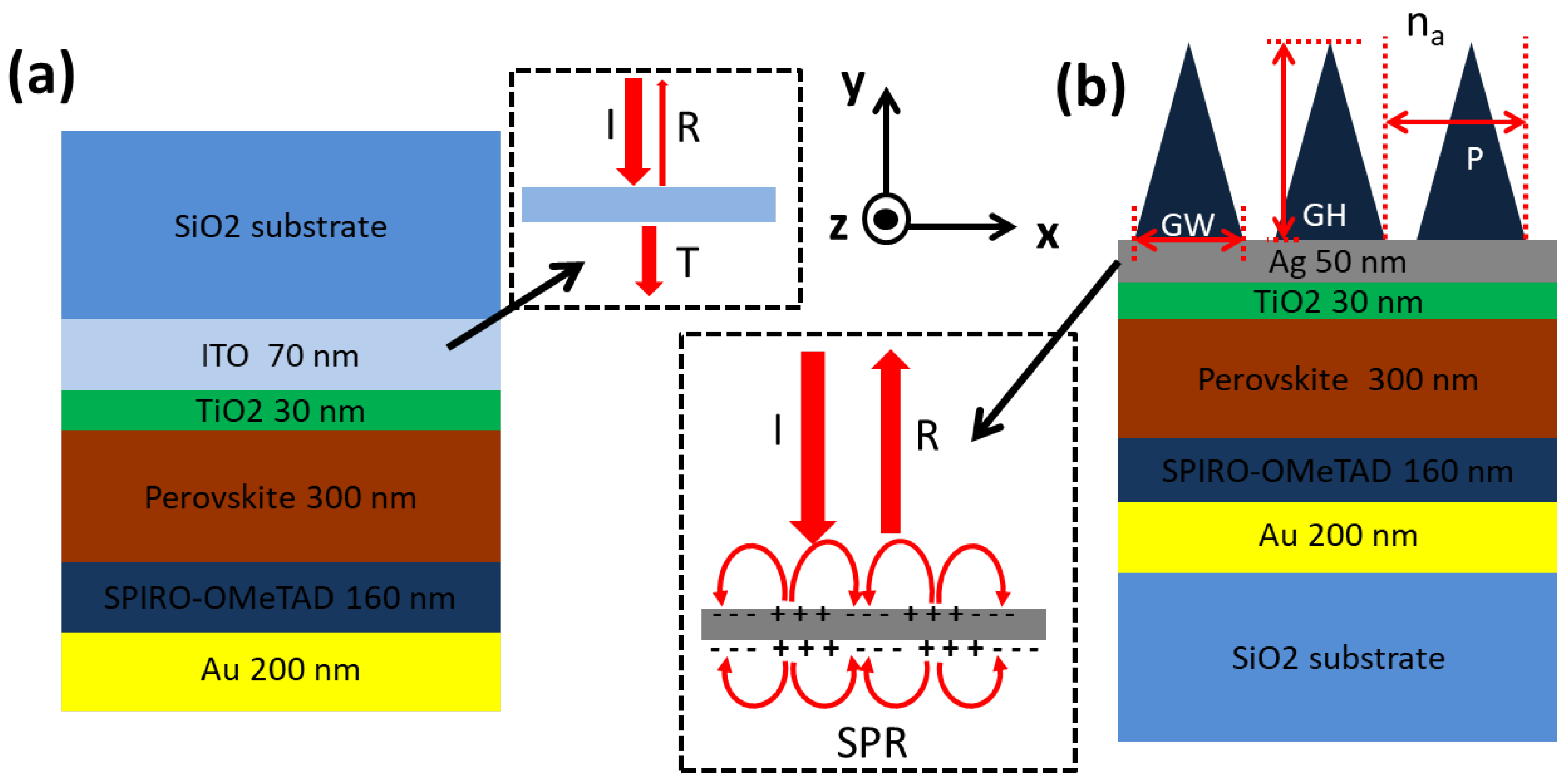
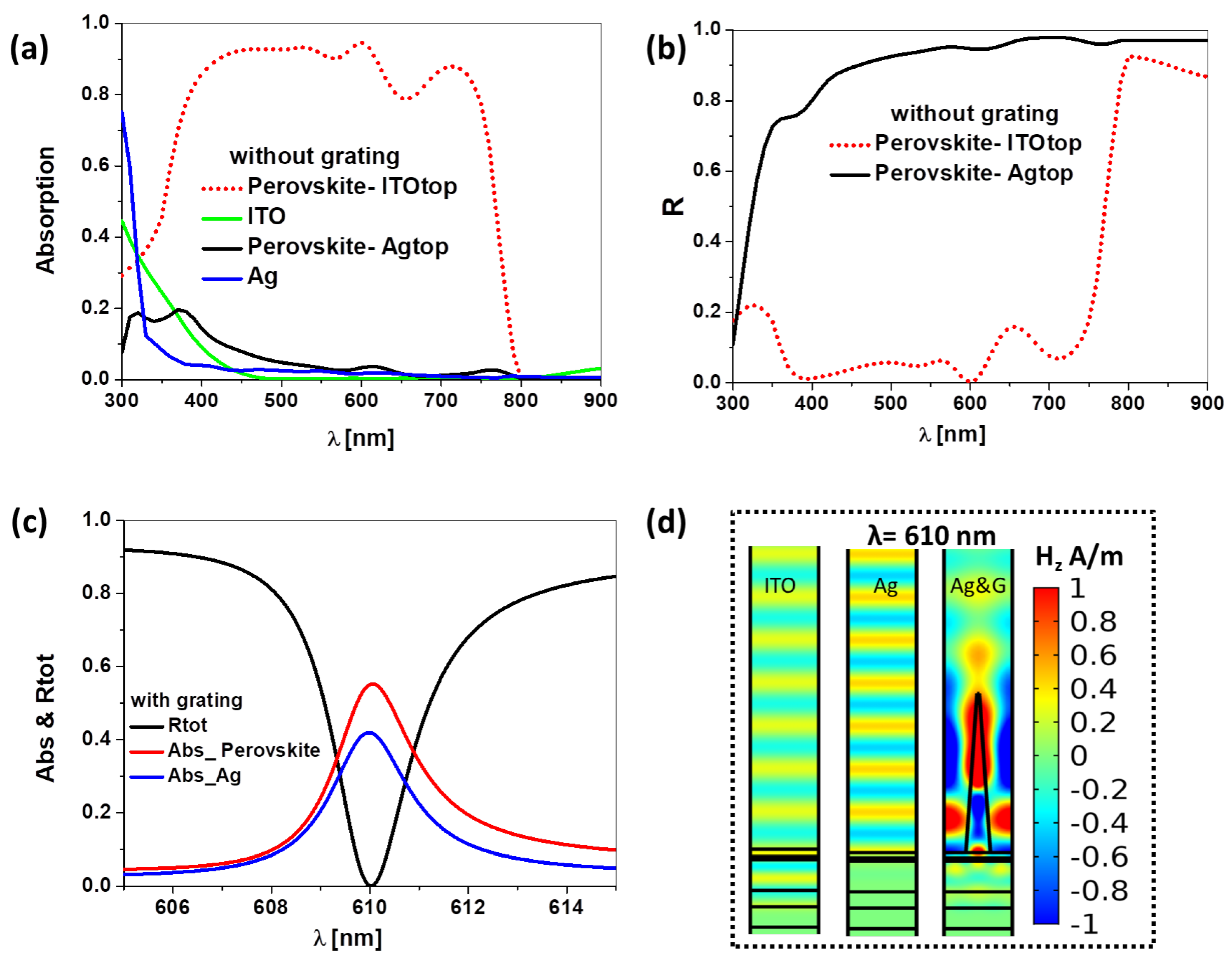
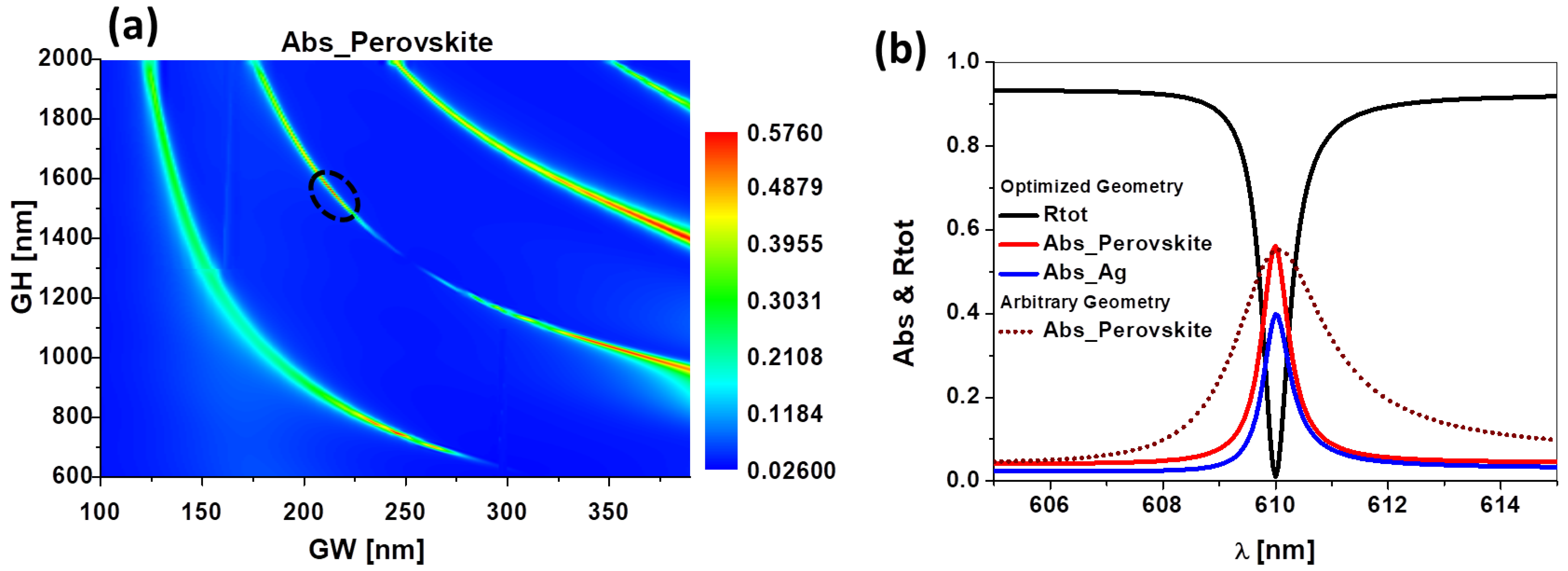
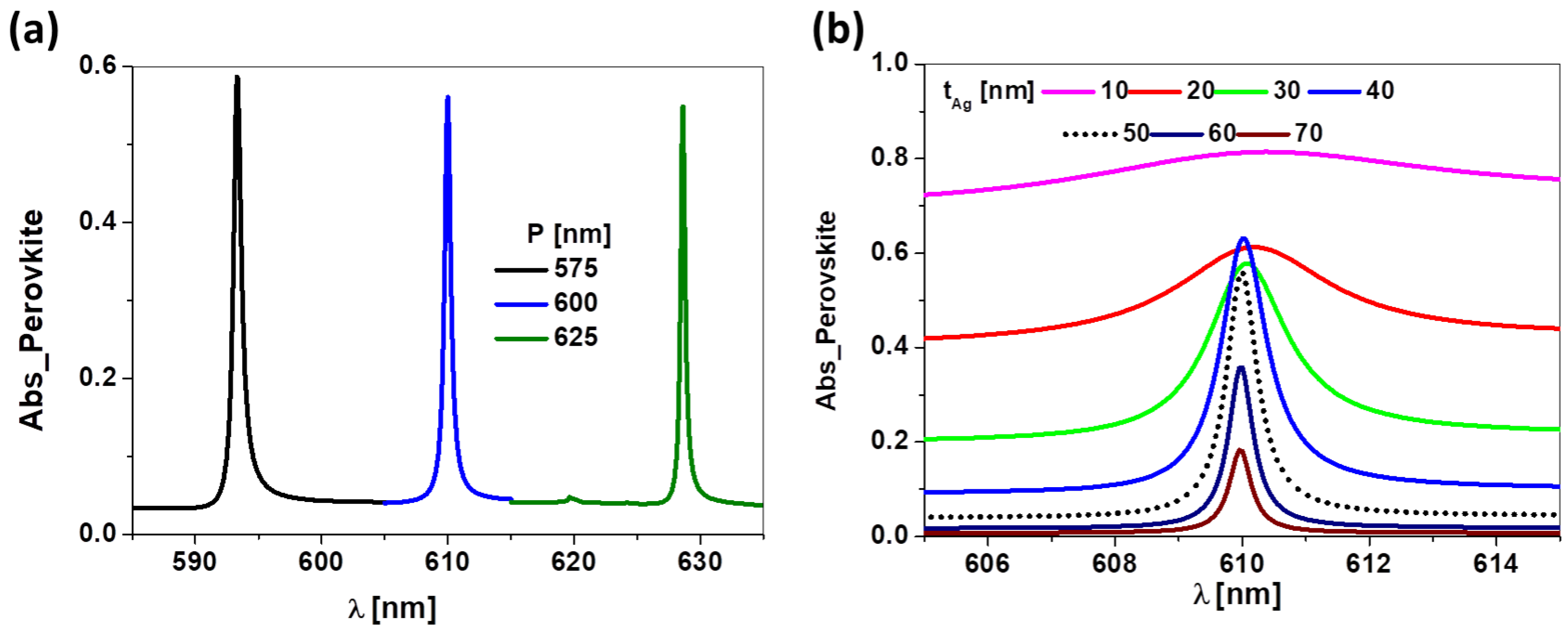
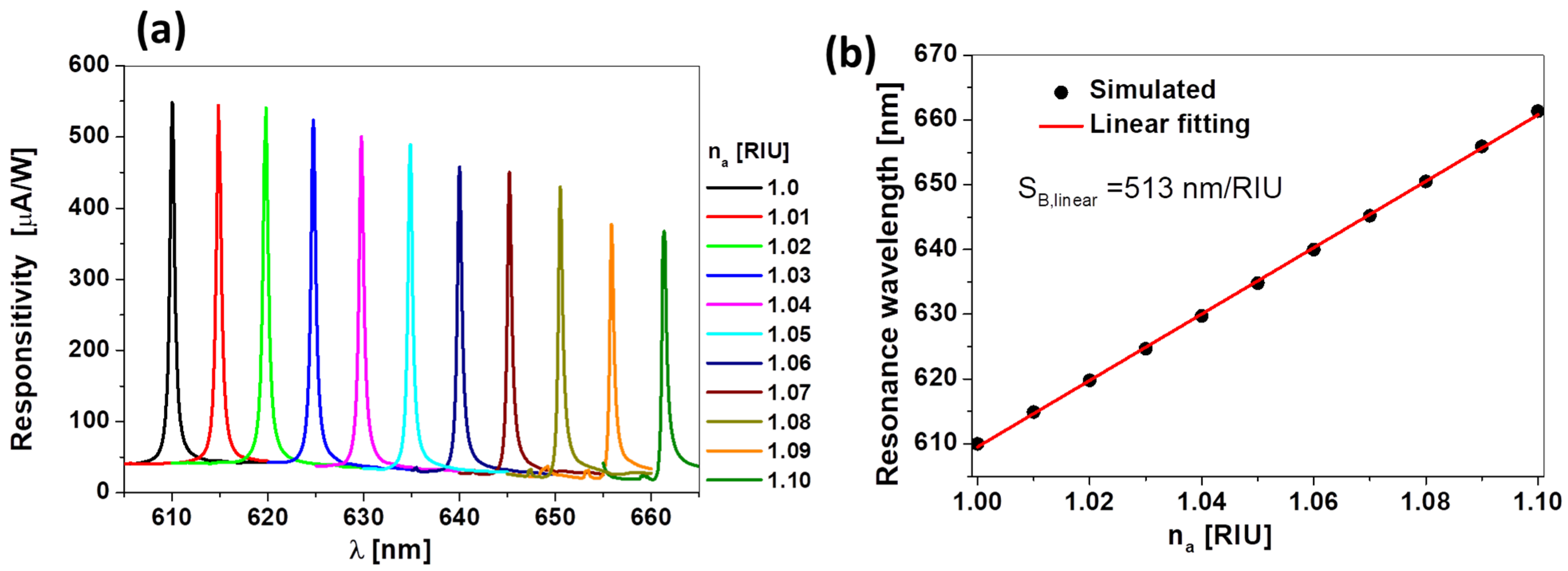
© 2019 by the authors. Licensee MDPI, Basel, Switzerland. This article is an open access article distributed under the terms and conditions of the Creative Commons Attribution (CC BY) license (http://creativecommons.org/licenses/by/4.0/).
Share and Cite
H. Elshorbagy, M.; Cuadrado, A.; Alda, J. Narrow Absorption in ITO-Free Perovskite Solar Cells for Sensing Applications Analyzed through Electromagnetic Simulation. Appl. Sci. 2019, 9, 4850. https://doi.org/10.3390/app9224850
H. Elshorbagy M, Cuadrado A, Alda J. Narrow Absorption in ITO-Free Perovskite Solar Cells for Sensing Applications Analyzed through Electromagnetic Simulation. Applied Sciences. 2019; 9(22):4850. https://doi.org/10.3390/app9224850
Chicago/Turabian StyleH. Elshorbagy, Mahmoud, Alexander Cuadrado, and Javier Alda. 2019. "Narrow Absorption in ITO-Free Perovskite Solar Cells for Sensing Applications Analyzed through Electromagnetic Simulation" Applied Sciences 9, no. 22: 4850. https://doi.org/10.3390/app9224850
APA StyleH. Elshorbagy, M., Cuadrado, A., & Alda, J. (2019). Narrow Absorption in ITO-Free Perovskite Solar Cells for Sensing Applications Analyzed through Electromagnetic Simulation. Applied Sciences, 9(22), 4850. https://doi.org/10.3390/app9224850





